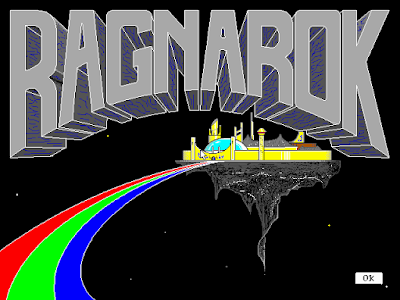From The CRPG Addict
Norsehelm Productions (developer and U.S. distributor); distributed in Europe by Optyk as Valhalla
Date Started: 28 January 2020
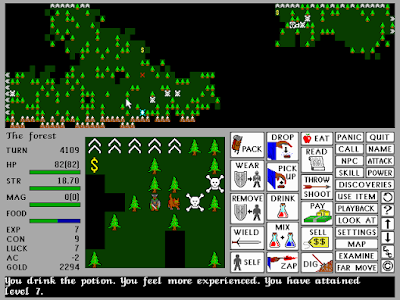 |
| Exploring a forest in Ragnarok. I’ve just killed two enemies and am fighting a wild dog. Apparently, I took a random potion in the middle of the battle, and it was a Potion of Experience. |
- A detailed game story and more interesting main quest, rooted in Norse mythology.
- A graphical user interface.
- More character skills, attributes, and options, which is saying a lot because NetHack was generous in this area.
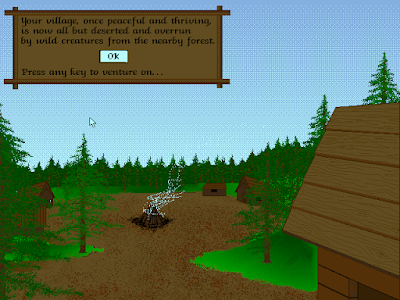 |
| The game opens in a peaceful village which, oddly enough, is not sacked by raiders. |
- Get Thokk to cry and bring her tears to Hela so she’ll release Balder, or alternately kill Thokk. (Hela required that every living being weep for Balder, and Thokk was the only one who didn’t. Thus, Hela’s demand can be satisfied by making Thokk weep or making her not living.)
- Find and return Mjollnir to Thor.
- Find and return Gjall (Heimdall’s horn), which has been turned into a snake and trapped in a well.
- Find and return Mimming to Freyr.
- Find and return Gungnir to Odin.
- Figure out how Tyr can fight with only one arm.
 |
| Fortunately, you’re not locked into your starting choice. |
Other attributes are constitution, luck, speed, eyes, and fingers–the latter two literally tracking how many of those things you still have, as it affects aspects of gameplay (for instance, the number of rings that you can wear). Besides attributes, the character can earn a variety of skills (e.g., alchemy, ironworking), powers (e.g., spellcasting, mind control), abilities (e.g., sixth sense, telepathy), and resistances (e.g., acid, cold). Some of these are earned by eating corpses as in NetHack, but others come from magic blessings, scrolls, polymorphing, and a variety of other rare means.
 |
| My character sheet at the end of this session. |
The interface is fantastic. A small-scale map occupies the upper half of the screen, showing the overall area map as far as you’ve uncovered it. A large-scale screen is set in the bottom half along with character attributes and buttons for most of the game’s commands. Each command also has a letter or function key. Thus, you could play with a mouse or entirely with the keyboard. I think this comes close to a near-perfect interface for a top-down game, although I concede that a perfect one would let me call and dismiss the command buttons as I needed them
 |
| Early-game shopping. |
Like any good roguelike, Ragnarok features an enormous selection of equipment, and most of it is unknown when you first pick it up. Scrolls, potions, rings, and other magic items are given descriptors (e.g., a “murky potion” is a Potion of Curing, a “birch wand” is a Wand of Fire) randomized at the beginning of each new game. As you learn them through experience or Scrolls of Identification, the game lists new ones that you find under their proper name. Any of them can be blessed or hexed (cursed), and there are scrolls that add blessings and remove hexes.
If I have one complaint, it’s that the game is a little bit over-generous on providing these items, both as random treasures and enemy loot drops. By the end of the first 9 screens, I had two Rings of Agility, a Ring of Crystal Skin, a Ring of Regeneration, a Ring of Protection, a Ring of Third Sight, and I’d found a bunch of Potions of Strength (which add permanently to strength) and Potions of Experience. But co-creator Robert Vawter says that many players considered it “less forgiving” than NetHack despite the lack of permadeath, so perhaps it gets a lot harder after you leave Midgard.
 |
| My overloaded inventory towards the end of this session. |
Combat has the same tactical considerations as Rogue and NetHack, which means that it’s far more tactical than it first appears. At a basic level, you bash yourself into enemies to fight them, and your melee weapons, shield, and armor either do their jobs or not. But with more experience comes a greater understanding of the system’s depth and breadth, which include a strong consideration of surrounding terrain, the use of throwing items and magic items, and finding ways to trick, delay, or evade some foes.
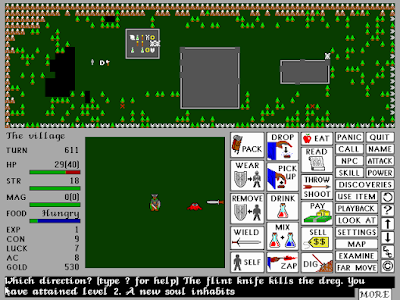 |
| Tossing a throwing knife at a “dreg,” which can splash you with acid. |
The only regression I see from NetHack is that the game doesn’t give you an explicit way to interact with NPCs, and there are friendly creatures wandering most of the maps. However, there are ravens who wander up to you and spontaneously give you hints.
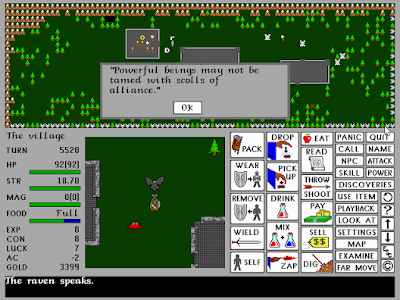 |
| Good to know. |
There were some interesting moments across the first nine screens. One object that I found repeatedly is a Scroll of Wonder. I don’t remember these from NetHack. When you read them, they seem to do random fantastic things. One of them created a river on the map I was standing on, obliterating some enemies as it did so. But another caused my character to hulk out, causing his armor to burst off his body. Unfortunately, his rings were made of stronger stuff, and instead of the metal giving way, the flesh did. I decided to reload rather than continue with no fingers. This was the third death I suffered after a couple of throw-away characters; my first was at the jaws of a bear. The second was when I accidentally took a Potion of Phasing (while testing potions) and rematerialized inside a tree.
 |
| Why do video games always make bears so dangerous? |
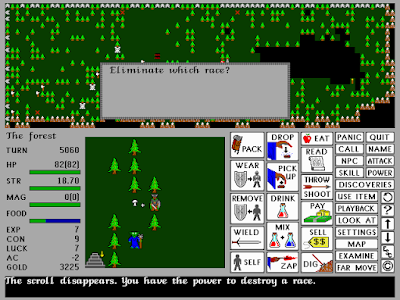 |
| You have no idea how many jokes I wrote and later deleted for this caption. |
Among the nine maps, I found three whirlpools which take you to other realms. I’d barely stepped out of one when I ran across Skinbladnir, the magical ship that folds small enough to fit into your pocket. I also found a stairway down into a dungeon that I explored briefly.
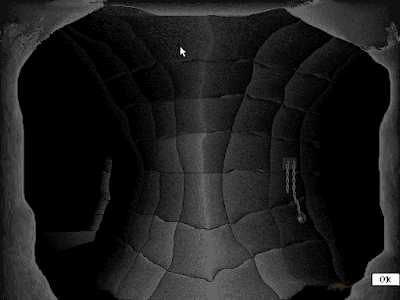 |
| Sometimes there are brief 3D cut screens between maps. |
As I was near finishing the village area, my character reached Level 10, and I got an option to change to a different character class. I chose a “woodsman,” which changed my icon and gave me some new weapon skills. I achieved the “Weaponmaster” ability upon reaching Level 9 as a viking.
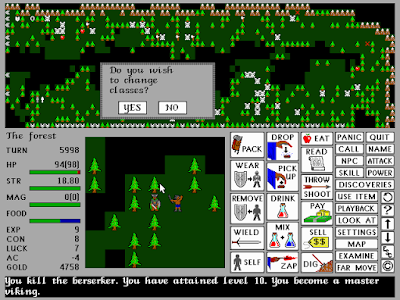 |
| Reaching apex level as a viking. I hadn’t even pillaged anything. |
There are still a lot of things left to learn about. Each character comes with a Ring of Soul Trapping, which stores the soul of the latest enemy killed, but I don’t know why (except there’s a suggestion that I could use it to bring Tokk’s soul to Hela). There’s an alchemy system that the alchemist character can use and a weapon-forging system that the blacksmith can use. The conjurer gets spells. You can apparently mix potions to create more powerful combinations. There’s a whole polymorphing system to explore, and some entire commands I don’t understand like “Aid Fellow Norseman.”
Late in this session, I came to realize that I might have made a mistake with versioning. In the United States, Norsehelm retained the rights to the game and marketed it themselves, eventually distributing it as freeware. They updated it a few times–the version I found was 2.5–so I figured I was playing the most advanced release. Later, I discovered that the European version distributed by a London publisher (Optyk), is actually more advanced in some ways. First, it offers a choice between “beginner” and “expert” modes. A beginner can back up the game every 200 turns, an expert every 4,000 turns. Either one is better than the typical roguelike, but I have to say I’m happier with the harder “expert” mode and the sense of angst and danger that it brings (but not the utter terror that you get with a pure roguelike).
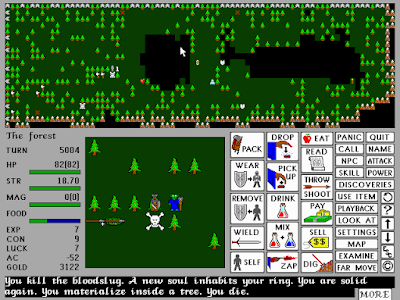 |
| Well, that was a hell of a sequence of events. |
Perhaps more important, Valhalla has improved audio. Ragnarok features just a few whiffs and clangs during combat, but Valhalla has more advanced combat effects plus ambient sounds such as birdcalls as you walk through the forest. I don’t know if those sounds are worth four hours of gameplay, but if the saved game ports from one to the other, then the decision will be made.
Time so far: 4 hours
Original URL: http://crpgaddict.blogspot.com/2020/02/game-354-ragnarok-1992.html

